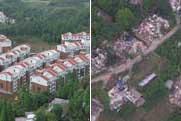China
China looks for breakthroughs in deep space exploration
Source: Xinhuanet | 11-01-2007 11:26
Special Report: Chang'e I -Journey to the MoonBEIJING, Oct. 31 (Xinhua) -- China's space program needs to build up technical expertise and make further breakthroughs in rocket technology before the country can launch a recoverable moon rover, say scientists.
Sun Jiadong, chief designer of China's lunar probe project, told Xinhua that as far as technical standards were concerned, China's space exploration equipment was much heavier than that made by developed nations, though the Chinese products were of the same quality, met the same criteria and performed the same tasks.
The lunar probe project had been developed on the basis of former scientific research results, including piloted space flights, Sun said.
China's first lunar orbiter Chang'e-1 -- named after a mythical Chinese goddess who, according to legend, flew to the moon -- blasted off on a Long March 3A carrier rocket on Oct. 24 from the Xichang Satellite Launch Center, in the southwestern province of Sichuan.
The 2,300-kg satellite, representing the first stage of the three-phase lunar probe project, would enter the earth-moon transfer orbit on Wednesday, a crucial step forward in its 1,580,000-km journey towards the moon.
It will relay the first picture of the moon in late November and will then continue scientific exploration of the moon for a year
Ye Peijian, the chief designer of Chang'e-1, said technical research had begun for the second phase of the moon exploration project.
"A soft landing vehicle needs a variable thrust engine, whereas the current engines all have fixed thrust," Ye said.
Sun said a dozen or so institutions were involved in the development of lunar rovers needed for the second and third phases of the project.
In line with the current design, one kilogram of lunar soil and rocks at most could be collected in the third stage, Ye said.
In the three-phase mission, a soft moon landing and launch of a moon rover will be completed around 2012, and another rover will land on the moon and return to the earth with lunar soil and stone samples for scientific research around 2017.
The moon rovers and the soft landing vehicle should meet high standards, as they were expected to stay on the moon for three to 12 months, Ye said.
"Since it takes time for China to develop and build new-generation carrier rockets, Chang'e-2 for the second-stage exploration will most likely lift off on the existing Long March 3A," Ye said.
However, earlier reports suggested the Chang'e-2 and 3 were possibly to blast off on new carrier rockets.
Some other scientists echoed Ye, pointing out that the limited thrust of Chinese rockets posed a major challenge for China's moon probe project, especially a manned mission.
Luan Enjie, chief commander of China's lunar probe project, told Xinhua that existing carrier rockets only had a thrust of 600 tons, whereas a thrust of 3,000 to 4,000 tons was needed to send humans to the moon. The larger thrust would allow a rocket to carry at least 100 tons.
Ye said China had no timetable for a manned moon landing.
Other challenges included monitoring antenna and limited human resources.
Ye said the United States had arranged monitoring antenna around the world, while China was limited to its own territory. Even at home, antenna for deep space exploration had yet to be installed.
Ouyang Ziyuan, another senior scientist in the moon probe project, said it suffered from a dearth of technical talent needed for a much larger capacity of carrier rockets and monitoring antenna.
China has already announced plans for the development of a new family of rocket launchers and the building of a space launch center.
The Long March 5 carrier rockets will be made in the northern coastal city of Tianjin while the new launch center will be located in the southernmost province of Hainan.
Media reports said the next-generation rockets would be able to lift 25 tons of payload to near-earth orbit, up from the current nine tons; and 14 tons of payload to geosynchronous orbits, up from five tons.
As the launch center in Hainan will not be ready until 2012, the new generation rockets will not blast off before 2013, media reports said.
Editor:Zhang Ning



